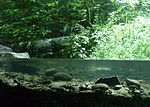Zigzag Ranger Station
1935 establishments in OregonBuildings and structures in Clackamas County, OregonCivilian Conservation Corps in OregonGovernment buildings completed in 1917Government buildings completed in 1935 ... and 4 more
National Register of Historic Places in Clackamas County, OregonPark buildings and structures on the National Register of Historic Places in OregonRustic architecture in OregonUnited States Forest Service ranger stations

The Zigzag Ranger Station is a Forest Service compound consisting of twenty rustic buildings located in Oregon's Mount Hood National Forest. It was built as the administrative headquarters for the Zigzag Ranger District. It is located in the small unincorporated community of Zigzag, Oregon. Many of the historic buildings were constructed by the Civilian Conservation Corps between 1933 and 1942. Today, the Forest Service still uses the ranger station as the Zigzag Ranger District headquarters. The ranger station is listed on the National Register of Historic Places.
Excerpt from the Wikipedia article Zigzag Ranger Station (License: CC BY-SA 3.0, Authors, Images).Zigzag Ranger Station
Mount Hood Highway,
Geographical coordinates (GPS) Address External links Nearby Places Show on map
Geographical coordinates (GPS)
| Latitude | Longitude |
|---|---|
| N 45.342063 ° | E -121.942024 ° |
Address
Zigzag Ranger Station
Mount Hood Highway 70220
97049
Oregon, United States
Open on Google Maps









